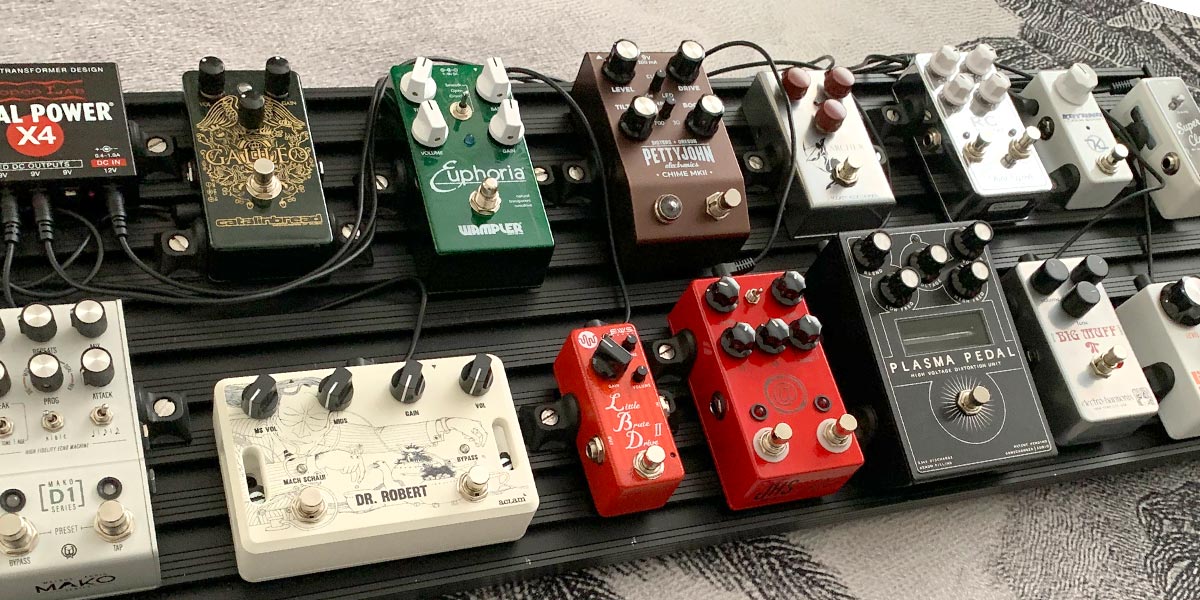
If you’re the lucky owner of one or more effects pedals, you’ve probably come across true bypass and buffered bypass.
Most pedals mention in the fine print whether it is a true or a buffered bypass pedal.
You will also come across terms such as ‘hard bypass’ or ‘hard-wire bypass’. With some reverb or delay pedals you will come across the term ‘trails’. Furthermore, some guitar pedals, and usually the more expensive ones, have the option to choose between true or buffered bypass. To help with the choice, I will discuss the differences and the advantages and disadvantages of both below.
True Bypass
When you connect a guitar to a guitar pedal and then the pedal to an amplifier, you make a connection between your guitar and the amplifier via the pedal. When the pedal is on, the guitar signal goes through the effects pedal circuitry and you hear the effect. When the pedal is off, there are two options. In the case of True Bypass, the guitar signal from the input goes directly to the output of the pedal and not through the effects pedal circuit. You take the effects pedal out of the circuit, as it were. When a True Bypass pedal is turned off, there is a direct (and often short) connection between the input and output of the pedal. Furthermore, some true bypass pedals sometimes suffer from switching noises when switching the pedal on and off.
Tip
If you’re not sure if your pedals are True or Buffered Bypass, turn the pedal off and unplug it. If you can still hear your guitar then it is a True Bypass pedal.
Buffered Bypass
In the case of Buffered Bypass it is different. When a buffered pedal is on, the guitar’s signal flows through the pedal’s circuitry and you hear the effect, much like a True Bypass pedal. When the pedal is off, however, the guitar signal still remains (partially) connected to the circuit. In most cases, the guitar signal passes through a buffer that ensures that the signal remains strong and ‘intact’. In technical terms, a buffer causes the impedance of the signal is converted from high to low. Many famous pedals also use a buffered bypass, including all Boss pedals, the Ibanez Tubescreamer and the Klon Centaur.

Pros and Cons of True Bypass
At first glance, True Bypass seems to be the best method. When a pedal is off, you also want it to be off and that the pedal has no effect on your tone. If you don’t use too many pedals (4 or 5), True Bypass is also the best choice in my opinion. However, if you have an extensive pedal board with many True Bypass pedals, you can suffer from ‘tone sucking’. True Bypass pedals increase the distance between your guitar and the amplifier. All cables have a certain capacity which in particular affect the highs in your signal. It is therefore good to use the shortest possible cables. The longer the cable, the greater this ‘treble bleed’ effect is. The cable then takes on the function of a kind of low-pass filter. By lowering the impedance with a buffer, the guitar signal will lose much less high.
Tip
Keep your guitar cables as short as possible, then there is the least chance of loss of highs in your signal.
Advantages and disadvantages Buffered Bypass
The advantages of pedals with buffered bypass therefore seem great, but here too there are disadvantages. A buffer uses transistors. All transistors suffer from thermal noise. This noise is also known as white noise because it has no specific frequency. The more buffers you use, the more noise you get. In addition, one buffer is unfortunately designed a bit better than the other, and bad buffers suffer from a lot of noise. Another disadvantage is that some vintage pedals, especially the fuzz pedals, don’t work well when you put a buffer in front of them. These pedals are specifically designed to handle a high impedance signal.

Tone sucking
One of the ways to determine if you have tone sucking at all is to perform the following experiment. Connect all pedals in series, i.e. one after the other, to your guitar and amplifier. Provide good, regulated and isolated power for each pedal. Then turn off all pedals and play guitar for a few minutes. Then plug your guitar directly into your amp and listen for any differences. Pay particular attention to the high in your signal. If you don’t hear any differences, there is no need for a buffer. If you do hear differences, a good buffer will in most cases help to restore your guitar signal to its full glory.
Conclusion
Your own ears are the best counselor when it comes to True or Buffered Bypass. If you’re happy with your sound, don’t change it. However, if you have problems with your guitar sound and your guitar sounds dull or dull, consider a buffer. You can of course also use a pedal with a good built-in buffer for this. Personally, I choose to use as many True Bypass pedals as possible on my pedal board. This gives me the most control over my sound. In this way I can also choose to use a buffer and where I place this buffer in the signal chain. If you’re considering a buffer, check out the Xotic Super Clean , Wamper dB+ or JHS Little Black Buffer.
